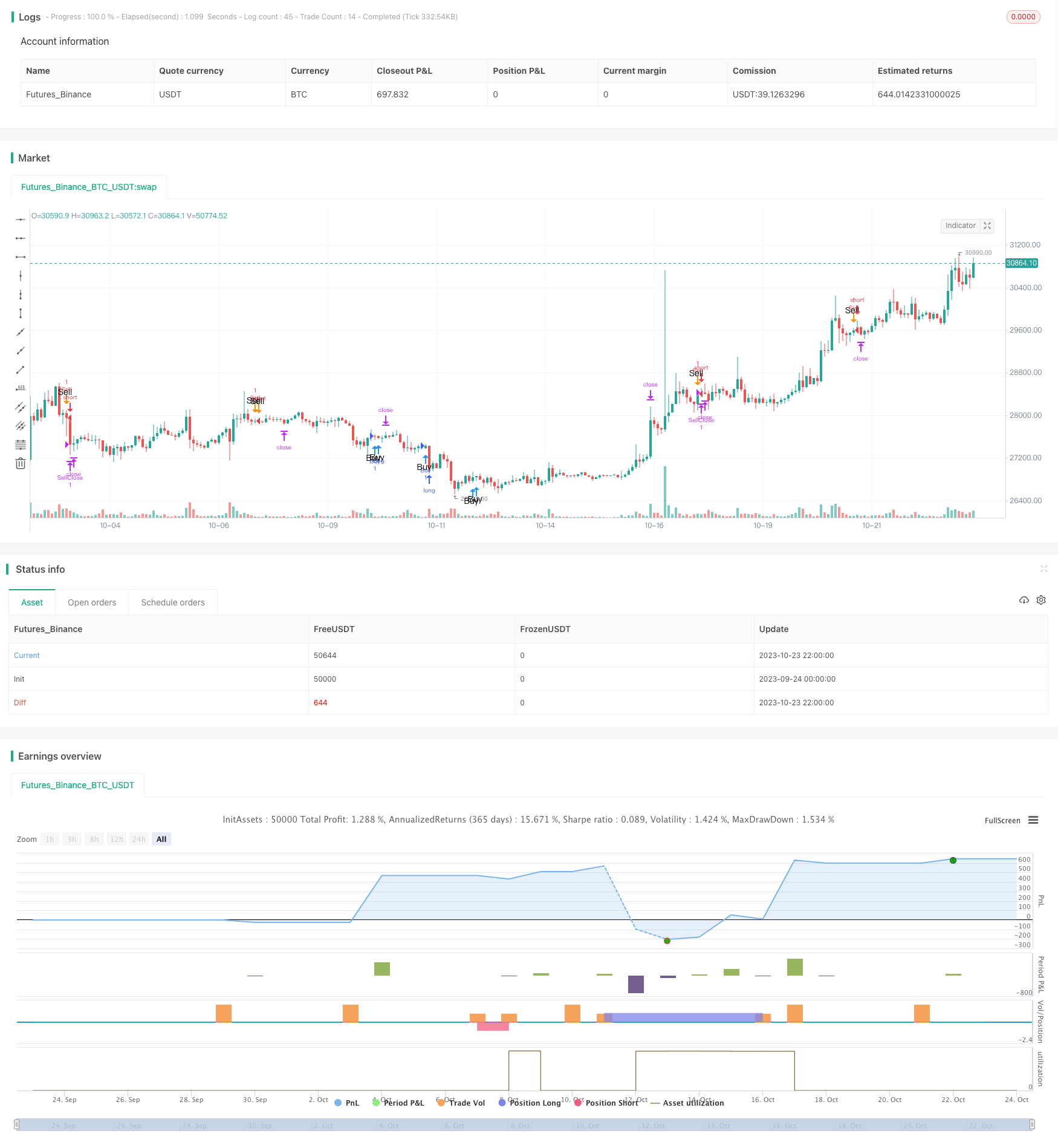
概述
本策略综合利用RSI、均线MACD、布林带和涨跌停因子,实现多因子动量轮动交易。策略首先判断多个技术指标是否同时发出买入或卖出信号,如果是,则进行相应的买入或卖出操作。同时,策略采用移动止盈和止损来锁定利润和控制风险。
策略原理
本策略主要包含以下几个部分:
判断因子
- RSI:计算14周期RSI,判断是否低于设置的买入线或高于设置的卖出线
- TD序列:计算涨跌停天数,判断是否达到买入卖出条件
- MACD:计算MACD和MACD历史值,判断是否达到买入卖出条件
- 布林带:计算20日布林带,判断价格是否触及布林带上下轨
入场与出场
- 买入条件:RSI、MACD、TD序列同时发出买入信号时,进行买入
- 卖出条件:RSI、MACD、TD序列同时发出卖出信号时,进行卖出
- 止盈:以固定点数或百分比进行移动止盈
- 止损:设定最大容忍损失点数,做止损
策略优化
- 调整RSI参数:优化RSI的周期参数
- 调整MA周期:优化均线的周期参数
- 调整入场条件:增加或减少入场信号
- 增加其他因子:结合更多技术指标和统计因子
策略优势分析
- 多因子组合,确保入场的准确性
本策略不仅考虑单一技术指标,而是结合RSI、MACD、TD序列等多个因子,这样可以减少因单一指标造成的假信号,提高入场的准确性。
- 动量特征,捕捉趋势
RSI、MACD等指标具有较明显的动量特征,能捕捉到股价的趋势变化。与均线等趋势跟踪指标相比,这些指标转折更为灵敏。
- 止盈止损机制,控制风险
移动止盈可以随着行情运行动态止盈,较好地锁定利润。止损设置则可以控制单笔损失。
- 策略思路清晰简单
本策略结合常用技术指标,具有一定的通用性。规则相对简单清晰,容易理解和操作。
策略风险分析
- 多头行情下效果较差
本策略以逆市操作为主,属于反转策略。在牛市中,采用本策略可能会频繁停损,效果不佳。
- 交易频率可能过高
若参数设置得太敏感,则交易频率可能会过高,增加交易成本和滑点损失。
- 指标发散风险
本策略依赖多种指标同方向信号,但有时各指标也可能出现分歧,从而发出错误信号。
- 止损被追穿风险
设置固定止损点数可能会被突破,可以设置动态止损或考虑换股来规避该风险。
策略优化方向
- 优化参数,减少交易频率
可以测试RSI的参数以及均线的周期参数,找到交易频率较低的组合。
- 增加统计因子,提高效率
可以结合股票自己的统计特性,如波动率、流动性等来设定参数,提高策略效率。
- 结合VIX等全市场指标
可以根据VIX等全市场恐慌指数来调整策略的参数,在市场 panic 时降低交易频率。
- 测试不同持仓时间
可以测试不同的持仓周期,判断长期持有或短期轮动对策略效果的影响。
- 优化和测试止盈止损策略
可以研究更先进的动态止盈止损方式,回测效果。
总结
本策略综合考虑多种技术指标,在确保较高入场准确率的基础上,采用移动止盈止损来锁定利润和控制风险。策略思路简单清晰,容易理解操作,可通过参数优化和指标优选进一步提升效果。但该策略更适合逆市和震荡行情,在持续上涨行情中效果可能较差。本策略为典型的多因子动量反转策略,可为股票轮动交易提供思路和参考。
/*backtest
start: 2023-09-24 00:00:00
end: 2023-10-24 00:00:00
period: 2h
basePeriod: 15m
exchanges: [{"eid":"Futures_Binance","currency":"BTC_USDT"}]
*/
//@version=2
strategy("RSI, TD Seq, MACD, BB Strategy - Calculation Trailing Profit",overlay=true)
RSIDifference = input(-7, minval=-50, maxval=50, title="RSI Difference")
TD = close > close[4] ?nz(TD[1])+1:0
TS = close < close[4] ?nz(TS[1])+1:0
TDUp = TD - valuewhen(TD < TD[1], TD , 1 )
TDDn = TS - valuewhen(TS < TS[1], TS , 1 )
TDcheckUP = iff(TD == 2, true, false)
TDCheckDOWN = iff(TS == 2, true, false)
[_, _, histLine] = macd(close, 12, 26, 9)
MACDCheckDown = iff(histLine > 0 and histLine[1] > 0 and histLine[2] > 0 and histLine[3] > 0 and histLine[4] > 0, true, false)
MACDCheckUp = iff(histLine < 0 and histLine[1] < 0 and histLine[2] < 0 and histLine[3] < 0 and histLine[4] < 0, true, false)
RSICal = rsi(close, 14)
RSICalNewUp = 50 + RSIDifference
RSICalNewDown = 50 - RSIDifference
RSICheckUp = iff(RSICal <= RSICalNewUp, true, false)
RSICheckDown = iff(RSICal >= RSICalNewDown, true, false)
basis = sma(close, 20)
dev = 2 * stdev(close, 20)
upperBB = basis + dev
lowerBB = basis - dev
BBCheckUp = iff(close > upperBB, true, false)
BBCheckDown = iff(close < lowerBB, true, false)
//BBCheckUp = false
//BBCheckDown = false
BuyCheck = iff(TDcheckUP == true and MACDCheckUp == true and RSICheckUp == true and BBCheckUp == false, true, false)
SellCheck = iff(TDCheckDOWN == true and MACDCheckDown == true and RSICheckDown == true and BBCheckDown == false, true, false)
ProfitStratA = input(50, minval=0, maxval=10000, title="Profit", step=0.5)
ProfitTrailingA = input(10, minval=0, maxval=10000, title="Profit", step=0.5)
useStopLoss = input(false, title="Use Stop Loss?")
LossstratA = input(145, minval=0, maxval=10000, title="Stop Loss", step=0.5)
colB = input(100, minval=0, maxval=100, title="0-show / 100-hide Strategy", step=100)
ProfitStrat = ProfitStratA * 10
ProfitTrailing = ProfitTrailingA * 10
Lossstrat = useStopLoss ? LossstratA * 10 : 1000000
if (strategy.position_size > 0)
strategy.exit("BuyClose", "Buy", trail_points=ProfitStrat, trail_offset=ProfitTrailing, loss=Lossstrat)
if (strategy.position_size < 0)
strategy.exit("SellClose", "Sell", trail_points=ProfitStrat, trail_offset=ProfitTrailing, loss=Lossstrat)
if (BuyCheck == true and strategy.position_size == 0)
strategy.entry("Buy", strategy.long, comment="Long Entry")
if (SellCheck == true and strategy.position_size == 0)
strategy.entry("Sell", strategy.short, comment="Short Entry")
plotshape(BuyCheck, color=blue, transp=colB, style=shape.arrowup, text="Buy\n", location=location.belowbar)
plotshape(SellCheck, color=orange, transp=colB, style=shape.arrowdown, text="Sell\n", location=location.abovebar)